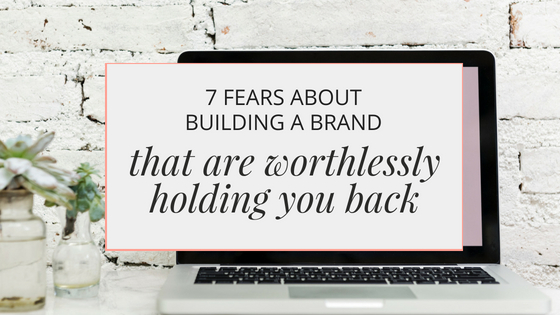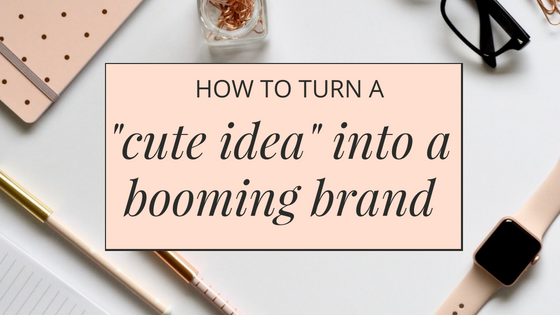Feeling nervous about building your brand? Don’t let these common concerns keep you down.

Let me guess, you have this totally awesome idea for a brand and you’re so excited about the IDEA of bringing it to life. Maybe you’ve even started to build it. You’ve put up your website, claimed your social media handles, and started to tell people about your brand.
But the further you start to go, the more impossible the whole thing seems. You’re starting to realize all the things you didn’t know and the road ahead is becoming more and more daunting. You spend nights Googling, reading blogs, looking for help figuring out what to do. Before you know it you’re left feeling totally overwhelmed, confused, and intimidated.
This whole thing has somehow gone from feeling really fun and exciting to feeling totally scary. Because honestly, if you are going to invest your time and money into something you don’t want to end up feeling like a total failure.
Look I totally get it. Your fears are legitimate. None of us wants to feel like we’re setting ourselves up to let ourselves down.
Here’s the thing though, those fears, they are totally and worthlessly holding you back. So, I wanted to tackle some of the most common ones I hear head on and show you why you should not let them keep you away from building your brand.
7 Fears About Building a Brand That Are Worthlessly Holding You Back
FEAR #1: I’m going to have to spend a lot of money working with a graphic designer in order to create something that looks really good.
Real talk, I am not going to tell you that design is not important. That would be a total lie. It is important!
BUT the amount of money you spend on design, that is not. When you are building your brand you do not need to spend a lot of money to get started. You can absolutely DIY and make your brand look awesome.
The thing that is really holding you back is feeling like you have no idea how to even approach design because that’s not your background or area of expertise. Guess what? We can totally solve that. With a few simple tips, you will feel so much more confident doing the work.
Still not sure? There are amazing free and inexpensive tools to get you started. One of my absolute favorites is Canva. With Canva you can create your brand style guide and logo absolutely free. Another favorite resource of mine is Fiverr which lets you find freelance help for as little as $5. There are also so many amazing resources out there like Logojoy and Creative Market which can help you create a truly stunning brand.
Seriously, the secret is spending money. It is knowing the basic principles of design and how to work with them.
FEAR # 2: It’s going to take a lot of time to get going and I simply don’t have any to spare.
Look we are all way too busy. You are never going to not be busy. You are never going to have that perfect window of time where you have no other commitments. It just isn’t going to happen.
What you have to do is decide to make the time. And, you have to learn how to work in a way that is smart and efficient.
One of the biggest mistakes people make when starting their brand is jumping head first into designing their logo and website. Ugh, this totally kills me because 99% of the time this ends up being a total waste of time. Your design really needs to come after you lay down the foundation for your brand.
You can find the time to bring your idea to life. You just need to find a way to be able to take one step forward without having to take two step backwards. You know what I mean? That means learning what those steps are and how you can avoid putting the cart before the horse.
FEAR #3: I have to have my products/services created before I can even think about my brand.
Nah! Seriously! You do not need to have your products/ services created before you start. Your brand is about so much more than that. As long as you have a strong idea of what you want to do, you are ready to start.
In fact, one of the strongest ways to launch your products/ services is by having created your brand ahead of time. This means that you are already going to be telling people about what you do. You’ll be getting the word out there and starting to build an audience. And guess what an audience is? Soon to be customers!
Your brand is the summation of everything you put out into the world. Your products/services yes but also your stories, images, partners, community, and you! Listen lady, even without that ready to deliver “thing” you already have so much you can get started with.
FEAR #4: There are already people doing what I do so I missed my shot. There’s no reason someone would want to choose me over another brand that’s already established.
Who cares? Honestly, who cares! Consider these examples:
- The Honest Company: diapers & baby products
- Away: luggage
- Glossier: beauty products
Were any of those things new or novel when they decided to launch their brands? Not a bit. It didn’t matter. What made all of the difference was the unique spin they put on them and the connection they were able to build with their customers.
At the end of the day, we all want to work with and buy from brands we know, like, and trust. If we feel like a brand totally gets us and shares our values then that’s who we’re going to go with.
It does not matter if someone is already doing what you do because no one else is going to share your same story, mission, vision, and values. You have so much uniqueness to bring to the table, you don’t even know!
FEAR #5: The whole thing is completely overwhelming. In order to be successful, you have to build a website, send emails, set up ads, be everywhere on social media all of the time, and still somehow find time to actually run your business.
First of all, let’s take a deep breath. Now let’s get to the root of the issue. You see other people running their businesses doing all of these things and feel like you have to do exactly the same. Problem is, you have no idea where to get started or where to focus your attention first. Am I right?
Imagine trying to put a puzzle together by simply moving a bunch of pieces around at the same time. You might get a few to connect but you’re going to get tired, overwhelmed, and just plain over it before your able to put the whole picture together.
Now imagine if those puzzle pieces were numbered and you knew exactly which piece to lay down first, second, third, and so forth. Before you know it you’d have the whole dang thing built and the process would have felt really simple and straightforward.
That’s how you want to approach your brand. Building your brand should be fun! And, when you know what to do, the whole process can actually feel really easy and empowering.
FEAR #6: Finding people who want to be my customers is going to really hard.
Guess what? Your customers already exist. Even better, they are all hanging out together. You just need to know how to find them.
It’s true. You’ve heard the phrase, birds of a feather flock together. Well, it totally applies to your customers. They’re gathering in the same Facebook groups, meetups, conferences, and more.
Once you have a really good idea of who you want to be your customer you are going to be able to find them. And, by learning how to listen in on the conversations they are already having you are going to quickly learn how to talk about your brand in a way that gets your attention.
The beautiful thing is, once you figure out where your customers are hanging out, you can be very focused and targeted in your marketing efforts. It’s going to totally simplify your life and save you boatloads of time.
FEAR #7: I have to have everything figured out before I get started.
Shoot if that we true than none of us would ever get anywhere. Figuring it out is all part of the process. You just gotta get started.
Not totally sure who your audience is? Take a guess, start pushing out your brand, see how it resonates and refine as you go.
Still trying to sort out how you want to package up your services? Start engaging with your audience and they’ll help you figure it out.
Feeling a little lost about what you should be posting to your social media feeds? Begin by sorting out your brand story, mission, vision, and values.
Point is, we learn by doing. Your brand will not be built overnight. But it will never be built if you don’t decide to take the leap and just get going.










